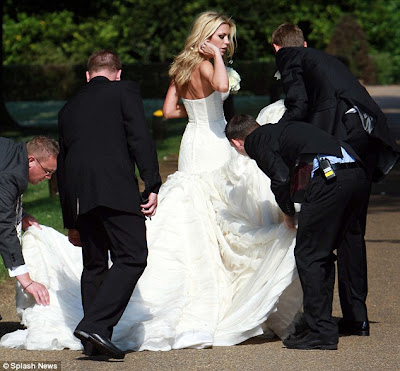
Berlin has been in the throes of a heated debate and local referenda about the fate of Tempelhof, the world’s first truly modern airport and the only part of Hitler / Speer’s masterplan for “Germania” to be completed. The imposing main structure of Tempelhof Airport finally ceased operations at the end of 2008 as part of the process that will eventually see Schönefeld take over as Berlin’s sole commercial airport. Once the focus of the famous airlift to save Berlin from the clutches of communism after World War II, Tempelhof airport has been transformed from "the mother of all airports" into a public park. Indeed as many ex- Communists from the East now form the majority on the city council defenders of Tempelhof have suggested they wanted it closed down as the potent symbol of the Luftbrücke, the airlift which broke the Soviet blockade of Berlin.
,
Eighteen months after ceasing aviation operations, fabled Tempelhof airport in the heart of Berlin re-opened on Saturday as the German capital's largest public park. Formerly one of the 20 largest buildings in the world, the hangars now hosts occasional fairs and festivals, such as the DMY International Design Festival, Bread & Butter, whilst the rest of the airport grounds are being transformed—courtesy of a whopping 60 million euro government scheme—into Tempelhof Park.
 Plan of Tempelhof
Plan of TempelhofThe historic airstrip, once described by star architect Norman Foster as "the mother of all airports," underwent a clean-up to transform the 380-hectare (950-acre) aviation hub into an expansive urban oasis. Although roughly the size of Central Park in New York, Tempelhof Park does not boast the hills, dales, ponds or leafy copses of its American counterpart. Instead, it presents open vistas of treeless, but breathtaking expanses, otherwise unheard of in an urban environment. The old airport terminal is still intact, but the typical aeronautic paraphernalia - the landing lights, signals and other gear - have been removed.
 Proposed redevelopment
Proposed redevelopmentAlthough the airport had been operation in some for over 80 years, it is the absolutely huge scale and striking form of the terminal building, conceived by German architect Ernst Sagebiel between 1934-1936 (based on Albert Speer’s masterplan), that resonates with visitors seeing it for the first time. The audacity of the 50+ metre cantilevered roof arc over the terminal and the clarity of the functional diagram are still, despite of any Nazi undertones, to be applauded architecturally. Tempelhof is the forerunner and exemplar of today’s super-sized terminal buildings designed by Foster, Piano and Rogers’s et al. Hugh Pearman points out:
“(Tempelhof) was designed to last until the year 2000. Somewhat surprisingly, it has. It is the only major airport in the world to have remained virtually unchanged over more than 60 years. What can it teach us? “
The airport was iconic for a number of reasons – not the least of which was it’s intended position as an international gateway in Speer’s masterplan of Welthauptstadt Germainia – it was also one of the world’s largest buildings (for a while), in 1927 it became the first airport with an underground railway station, and was the hub during the Berlin Airlift.
After years of debate Berliners voted in a referendum held in Berlin, on April 27, 2008 to finally close down this historic airfield. However, Tempelhof will remain the effective monument to the Berlin Airlift of 1948-1949.

In June 1948 the Soviet Union made an attempt to take control of the whole of Berlin by cutting off surface rail and street access to and from the western part of the city. If successful this action would have resulted in effectively starving out over 2 million Berliners of food supplies. The US Truman administration’s reaction to the Blockade was to provide a daily airlift by the Allies to ensure that food and supplies continued to reach Berliners living in the western Sector. More than 5,000 tons of supplies were delivered daily. The “Airbridge” lasted until September 1949 when the Soviet government finally lifted the blockade. Popular stories about “raisin-bombers” and the ‘Chocolate Pilot’ are still told to children today.

For many Berliners, especially the older generation, Tempelhof remains a symbol of freedom and belongs to Berlin as much as the Brandenburg Gate. Even Germany’s conservative Chancellor, Angela Merkel, pointed out that “to many people and me personally this airport with the Airlift Memorial is a symbol of the city’s history”.
The airport was built by the National Socialists between 1936 and 1941 by Ernst Sagebiel, in typical Nazi monumental style, complete with carved eagles at the entrance and a roof constructed to hold an audience of 100,000 people watching military parades and air shows. Sagebiel was listed twice in the Guinness Book of Records for his architectural feats which included the Former Air Ministry as the largest office building in Europe. Tempelhof was designed to become the largest air travel terminal of its day, replacing the building that had stood on this site since 1923.

But the bulldozers aren't finished with Tempelhof just yet. Starting in 2013, the new park will undergo a four-year, 60-million-euro ($48 million) facelift to become the home of the 2017 International Garden Exhibition. By then, it should look a lot more like its storied New York counterpart. Let’s hope that the project respects the unique contribution of this site to transport, to history and being built by fascists through the Berlin Airlift to the freedom enjoyed in Europe today.
For updated info on the campaign to preserve Tempelhof and obtain UNESCO heritage status for the site see;
http://live.benbeath.com/flughafen-templehofFor the story of the closure of Tempelhof see;
http://daithaic.blogspot.com/2008/10/berlin-tempelhof-airport.html
For more on
Architecture and
Design see
ArchiBlogs in the Blog sidebar.
 The bride, who gave birth to the couple's first child just three months ago, showed off her size 6 figure in a white lace corset dress with a tiered silk skirt is expected to cost £ 10,000, which she and drop earrings and loose tousled hair. She managed away from the traditional romantic bridal make-up, instead choosing dramatic smoky eyes and vampy red nail polish.
The bride, who gave birth to the couple's first child just three months ago, showed off her size 6 figure in a white lace corset dress with a tiered silk skirt is expected to cost £ 10,000, which she and drop earrings and loose tousled hair. She managed away from the traditional romantic bridal make-up, instead choosing dramatic smoky eyes and vampy red nail polish.
































